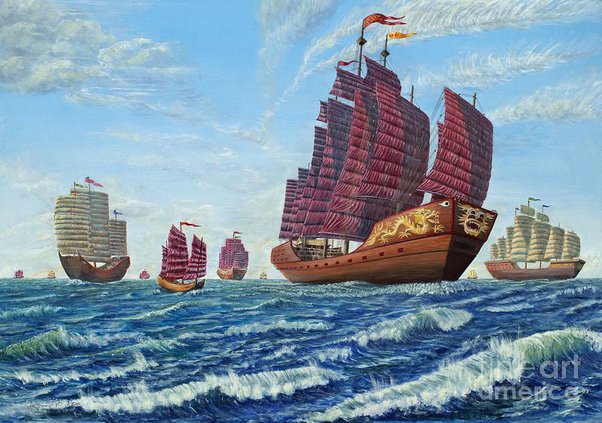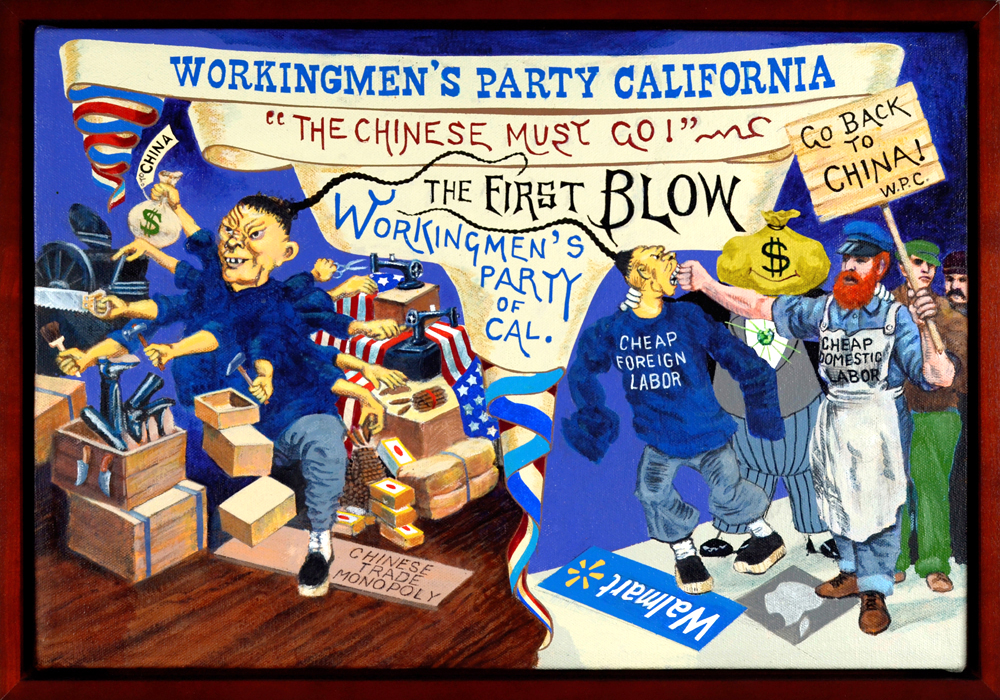
There are several speculative accounts by a few historians that fleets of Chinese ships, or ‘Junks,’ reached the West Coast and Mexico decades, or even centuries, before the first contact by Spain. One even suggests Chinese influences among the Olmec peoples in what is now Mexico. Whether true or not, such contacts left few footprints. By 1500, the Chinese emperor forbade the building of ocean-going Junks with more than two masts. Long-distance voyages over oceans thus came to an end.
Things changed by the 19th century. New Chinese immigrants in the early 1800s were small, only a few hundred per year. But around 1850, they started arriving in much larger numbers, in the tens of thousands. The large majority were young men seeking to make a fortune in the gold mines, or at least enough money to remit some back to their families.
Few of the first wave of Chinese who moved to America were women. In 1850, the Chinese community of San Francisco consisted of 4,018 men and only seven women. By 1855, women made up only two percent of the Chinese population in the United States, and even by 1890, this had only increased to 4.8 percent.
Under Qing dynasty law, Han Chinese men were forced under the threat of beheading to follow Manchu customs, including shaving the front of their heads and combing the remaining hair into a queue. Historically, to the Manchus, the policy was both an act of submission and, in practical terms, an identification aid to tell friends from foes. Because Chinese immigrants returned as often as they could to China to see their families, they could not cut off their often-hated braids in America and then legally re-enter China. [Wiki]

Chinese immigrant workers played a critical role in the construction and completion of the West-to-East section of the transcontinental railroad. Blasting the tunnels in the high Sierra was quite dangerous, and American workers refused to do it. According to Wiki, “The construction crew grew to include 12,000 Chinese laborers by 1868, when they breached Donner summit and constituted eighty percent of the entire workforce.”
With the railroad’s completion, Chinese who remained in the U.S. faced segregation and housing discrimination wherever they went. Settling in small enclaves, these grew into a nationwide network of ‘Chinatowns’ in major U.S. cities, especially in San Francisco.
If the Chinese migrants had children born in the United States after the 14th Amendment, those children would automatically acquire American citizenship. However, the immigrants themselves would legally remain as foreigners “indefinitely.” Unlike European immigrants, the possibility of naturalization was withheld from the Chinese.
After the Emancipation Proclamation of 1863, many Chinese Americans immigrated to the Southern states, particularly Arkansas, to work on plantations. The tenth U.S. census of Louisiana showed that 57% of interracial marriages between these Chinese American men were to African American women and 43% to European American women.
Because of Chinese exclusion from unions, American businesses would use Chinese workers as strikebreakers. A prominent case was in Western Pennsylvania. Beaver Falls Cutlery Company, Beaver Falls, PA, is a former company that manufactured steel cutlery, razors, and pocket knives. The company was founded as Binns & Mason in 1866 by skilled cutlers from Sheffield, West Riding of Yorkshire, England, as a small enterprise making pocketknives in Rochester, Pennsylvania. It briefly became The Pittsburgh Cutlery Company. It was purchased in 1867 by the Harmony Society, brought to Beaver Falls, and developed for mass production, to employ 300 people and cover a two-acre site. In 1872 it suffered a labor dispute which was resolved by employing up to 225 Chinese workers.
The North Adams strike (also called North Adams Scandal) was another example in Massachusetts. In 1870 shoe workers of the Order of the Knights of St. Crispin went on strike against Calvin T. Sampson’s Shoe factory in North Adams, MA. The strike was broken when the factory superintendent, George W. Chase, fired the Irish workers, replacing them with newly employed seventy-five Chinese men from California.[Wiki] Bringing national attention to North Adams, the event started a nationwide trend of bringing in scab labor. It helped perpetuate the concept of immigrants coming to the United States to steal jobs, which led to much hostility towards Chinese immigrants nationwide.
California Workingmen’s Party

The Workingman’s Party, centered in the Bay area, led the attacks on Chinese workers in the streets and legislation. The following is a relatively mild comment from one of their leaders:
“We are men, and propose to live like men in this free land, without the contamination of slave labor, or die like men, if need be, in asserting the rights of our race, our country, and our families.
California must be all American or all Chinese. We are resolved that it shall be American, and are prepared to make it so. May we not rely upon your sympathy and assistance?
With great respect for the Workingman’s Party of California.
Dennis Kearney, President
H.L Knight, Secretary” Source: Dennis Kearney, President, and H. L. Kn
On February 19, 1862, the 37th United States Congress passed An Act to Prohibit the “Coolie Trade” by American Citizens in American Vessels. [Wiki] The act, called the Anti-Coolie Act of 1862 in short, was passed by the California State Legislature to appease rising anger among white laborers about salary competition created by the influx of Chinese immigrants at the height of the California Gold Rush. The act sought to protect white laborers by imposing a monthly tax on Chinese immigrants seeking to do business in California.
Starting as early as 1865, Southern newspapers began printing editorials and letters calling for Chinese labor to be the new labor supply. This interest was partly sparked by accounts boasting that the Chinese contract labor contributed to the increase in Cuban agricultural imports. The Chinese effectively became the new labor supply but were positioned societally at the same level as African Americans.
The discrimination and mistreatment of Chinese Americans continued into the 20th Century. According to Wiki:
“The Immigration Act of 1917 banned all immigration from many parts of Asia, including parts of China, and foreshadowed the Immigration Restriction Act of 1924. Other laws included the Cubic Air Ordinance, which prohibited Chinese from occupying a sleeping room with less than 500 cubic feet (14 m3) of breathing space between each person, the Queue Ordinance,[83] which forced Chinese with long hair worn in a queue to pay a tax or to cut it, and Anti-Miscegenation Act of 1889 that prohibited Chinese men from marrying white women, and the Cable Act of 1922, which terminated citizenship for white American women who married an Asian man. The majority of these laws were not fully overturned until the 1950s, at the dawn of the modern Civil Rights Movement. Under all this persecution, almost half of the Chinese Americans born in the United States moved to China seeking greater opportunities.

Problems did not cease with the arrival of the 21st Century. A prominent incident was the suicide of Danny Chen, a Chinese American soldier deployed to Afghanistan. After ceaseless racial harassment by other soldiers and an officer, he took his own life on Oct 3, 2011.
‘Military investigators found that Chen was “the target of ethnic slurs, taunts, and insults, and endured physical attacks at the hands of his fellow soldiers before his death”.[6][9] Chen was found to have been physically and verbally mistreated and abused by his superiors, who appeared to single him out for being Chinese-American. This abuse and bullying occurred on a daily basis for six weeks before his death. As the first and only American soldier with Chinese ancestry in the unit, he was singled out, endured taunts including racial slurs and insults such as “gook”, “chink”, “Jackie Chan”, “Soy Sauce”, and “dragon lady”; assigned excessive guard duty to the point of exhaustion, made to do push-ups while holding water in his mouth, and put in a “simulated sitting position” and mercilessly kicked by other soldiers using their knees, among other abuses, bullying, or violent tactics… Military investigators found that Chen was “the target of ethnic slurs, taunts, and insults, and endured physical attacks at the hands of his fellow soldiers before his death”.[6][9] Chen was found to have been physically and verbally mistreated and abused by his superiors, who appeared to single him out for being Chinese-American. This abuse and bullying occurred on a daily basis for six weeks before his death. As the first and only American soldier with Chinese ancestry in the unit, he was singled out, endured taunts including racial slurs, assigned excessive guard duty to the point of exhaustion, made to do push-ups while holding water in his mouth, and put in a “simulated sitting position” and mercilessly kicked by other soldiers using their knees, among other abuses, bullying, or violent tactics….On October 3, 2011, the day he died, other soldiers forced him to crawl on gravel for over 100 meters (330 ft) while carrying equipment as his comrades “mercilessly threw rocks and stones at him without showing any remorse.”
Eight soldiers and an officer faced court-martial. All received relatively light sentences or dismissals from the Army with negative discharges.
Chinese Americans today are often bracketed as the ‘model minority’ due to educational achievements and success in starting small businesses. While these are true, the label is designed to drive a wedge between Chinese Americans and other minority nationalities, such as Puerto Ricans and African Americans. It also masks the fact that solid majorities of the ‘ModelMinorities are working class, and bear the same burdens of other workers of all nationalities. For the most part, the ploy has been unsuccessful. Chinese Americans played prominent roles in the ‘Rainbow Coalitions’ launched by Jess Jackson’s presidential campaigns and similar projects.
carld717, thank you for this excellent post!
On the point near the end regarding the “Model Minority” propaganda, it should be noted that it is not simply meant to “drive a wedge between Asian Americans and other oppressed nationalities” (the most common view among middle-class academics and neoliberalism-aligned 501(c)3’s), but it is a lie to make invisible the MAJORITY of Asian peoples in the U.S. who are not only immigrant, but working-class.
I would also encourage readers to study the works of Professor Mae Ngai including four books on Chinese Americans and U.S. immigration history: https://history.columbia.edu/person/ngai-mae/
Impossible Subjects: Illegal Aliens and the Making of Modern America (Princeton 2004). Winner of six book awards including Frederick Jackson Turner prize (OAH), Littleton Griswold prize (AHA), Lora Romero prize (ASA), Theodore Salutos prize (Immigration and Ethnic History Society).
The Lucky Ones: One Family and the Extraordinary Invention of Chinese America (Houghton Mifflin Harcourt 2010; paperback edition, Princeton University Press, 2012; in Chinese translation (幸运之家) from Commercial Press, Beijing (2015) and (幸運寵兒) from University Press of National Taiwan Normal University, Taipei (2014).
Editor (with Jon Gjerde), Major Problems in American Immigration History, second ed. (Cengage 2011).
The Chinese Question: The Gold Rushes and Global Politics (WW Norton 2021). Forthcoming in Chinese translation (China Times, Taipei) and Korean translation (Cum Libro, Seoul).
Thanks, Taiji. I made the change you suggested. I know Mai Ngai well. We were in the LRS together, and I often stayed at her place in NYC when I had to visit the city. She’s gone on to do quite well academically. –CarlD